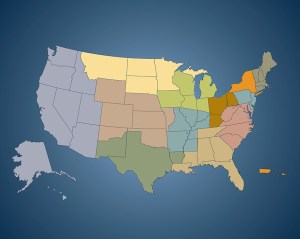Summary of Economic Activity
Economic activity in the Twelfth District slowed slightly during the April to mid-May reporting period. Employment levels were generally stable amid some layoffs and attrition without replacement. Wages were up slightly, and prices across industries rose modestly. Retail sales and demand for consumer and business services softened somewhat. Manufacturing activity declined slightly and conditions in agriculture and resource-related sectors weakened somewhat. Conditions in residential and commercial real estate markets softened slightly, while financial sector conditions were largely unchanged. Conditions weakened further in community support and services amid declines in funding and sustained demand. Looking forward, contacts expressed a slightly more positive outlook on the economy relative to the prior reporting period, although the overall expectations for economic conditions continued to be generally downtrodden.
Labor Markets
Employment levels were generally stable in recent weeks. While headcounts were steady in many sectors, a number of contacts in real estate, manufacturing, agriculture, finance, and nonprofits reported lower employment from layoffs and attrition. Economic uncertainty and slowing consumer demand led many businesses to take a wait and see approach in hiring. Employers looking to hire had an easier time overall, though recruiting challenges remained for some specialized trade and technical positions. Firms received more applications, though not all applicants’ skill sets met employers’ needs. Several contacts noted that recent graduates had difficulty finding jobs and reported lower turnover and voluntary separations.
Wages grew slightly overall, in line with the prior reporting period, partially in response to explicit employee requests to cover higher costs of living. Nonetheless, several contacts in sectors such as agriculture, food services, and travel services reported that wages were unchanged in recent weeks. A retailer commented that the softer labor market weakened competition for candidates and alleviated wage pressures. Another contact observed that on-the-job training needs and costs increased.
Prices
Prices rose modestly as in the prior reporting period. Costs rose, including those for firms’ inputs, such as metals, concrete, parts and equipment, as well as costs for imported merchandise for retail sale, insurance, and utilities. As a result, many businesses raised their final prices. In some cases, firms explicitly included a separate tariff line for items or contingencies in their price quotes and contracts. One contact observed that price increases that had been implemented in anticipation of certain tariffs were not rolled back once those tariffs were removed.
Community Conditions
Conditions in the community support and services sector deteriorated as federal funding and charitable donations dropped notably. Demand for community and support services rose somewhat as individuals and households continued to seek housing, health care, and food assistance. Meanwhile, many nonprofit organizations reduced their staff and were less able to meet basic community needs. Availability of affordable housing continued to be a concern for contacts across the District.
Retail Trade and Services
Retail sales weakened slightly on net over the reporting period. Some retailers, particularly from tourism-driven areas, attributed sluggish sales to lower foot traffic and cautious spending behavior from consumers. Sales at other retailers, including grocery stores, home centers, and sports apparel stores were reportedly steady. A contact from Arizona observed higher sales of non-food and discretionary items ahead of potential reinstatement of higher tariff rates. Some retailers had adequate inventory levels. Others had insufficient inventory due to supply chain disruptions as some import orders were cancelled in response to trade policy changes.
Activity in the consumer and business services sectors moderated somewhat in recent weeks. Demand for leisure travel slowed further as consumers postponed or canceled their trips. Business travel remained subdued with fewer conferences and group events due to economic uncertainty and cutbacks in government spending on travel and grants. Major tourist hubs across the District highlighted a substantial drop in international visitors which led to lower consumer spending and weaker local economic activity. Demand for medical testing, legal, and other professional services was largely unchanged. However, one contact noted that business clients switched to cheaper service packages, such as for security and custodial services, as a cost saving measure.
Manufacturing
Manufacturing activity slowed slightly since the previous reporting period. Demand for some final products, such as equipment and apparel, weakened following earlier spikes in orders ahead of tariff increases. Demand for intermediate goods also softened. For contacts across the District, costs of raw materials and components rose in response to changes in trade policy. Some manufacturers were reportedly able to negotiate sharing the cost of tariffs with their vendors abroad. Others passed on cost increases to their customers or planned on doing so when current tariff pauses expire in July.
Agriculture and Resource-Related Industries
Conditions in agriculture and resource-related sectors weakened slightly. Exports fell for products such as nuts, tree fruit, beef, and logs. As a result, producers turned to domestic markets. While domestic demand was largely stable, it was insufficient to absorb the extra supply, which led to producers receiving lower prices for their products. Additionally, contacts noted a shift in demand away from some higher-priced products, such as organic produce. While yields of some agricultural products such as nuts were solid, supplies of others such as cattle and logs were down. Growers continued to raise concerns about anticipated increases in input costs, like fertilizer. A contact in the Pacific Northwest paused capital investment plans amid economic and trade policy uncertainty.
Real Estate and Construction
Activity in the residential real estate market weakened slightly in recent weeks. Construction continued to slow as builders faced overall softening demand, high costs, and elevated uncertainty. Sales of single-family homes slowed and shifted towards smaller, lower-priced properties. However, a few contacts in parts of the Mountain West region observed that population growth kept demand solid. Some potential buyers opted to rent instead, given the elevated prices and high mortgage rates. Multifamily rents grew in some areas, such as in Southern California where recent fires increased rental demand. Rents declined in other areas, such as the Mountain West, where more units on the market increased supply.
Conditions in commercial real estate weakened somewhat, as in the prior reporting period. Demand for commercial space leases fell overall as tenants waited for more clarity about trade policy and economic conditions. Contacts reported more vacancies, including for retail and office space. Leasing demand was somewhat bolstered by tenants with stronger financial positions. Construction of new commercial property remained slow, particularly in the private sector, because of uncertainty about future economic conditions and the effects of trade policy on building costs and materials availability. Construction activity for public sector projects such as transportation and utilities remained solid.
Financial Institutions
Conditions in the financial sector changed little over the reporting period. Consumer loan demand was unchanged on net but varied more by region than in the prior reporting period. Contacts in California and Washington saw softer demand for loans while contacts in Idaho and Utah reported that demand was more robust. Demand for business loans remained subdued as some firms postponed new investments. Most contacts in the banking sector reported good credit quality, but a few others noted rising credit card delinquencies and some losses in their commercial real estate loan portfolios. Reports also noted slow growth in deposits.
Visit the Federal Reserve Board of Governors’ Beige Book page for the national summary, reports from all 12 Districts, and archives dating back to 1996.


